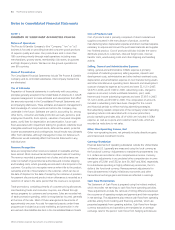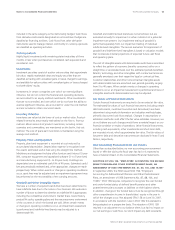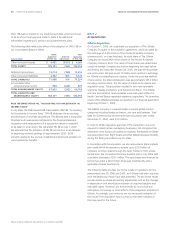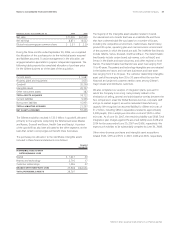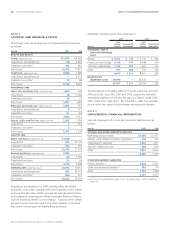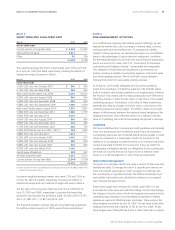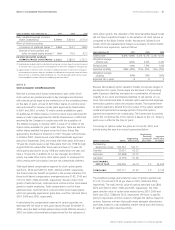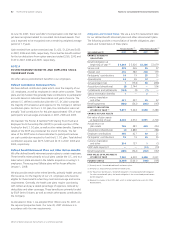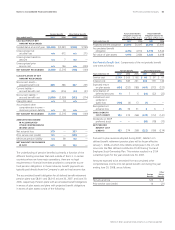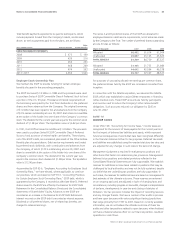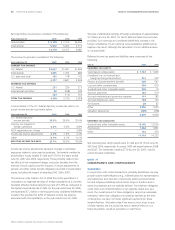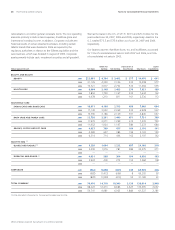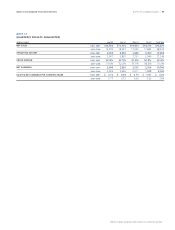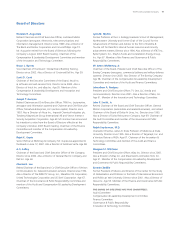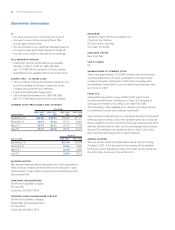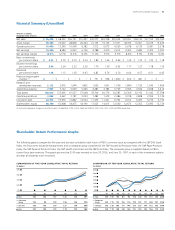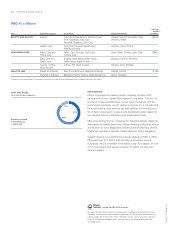Proctor and Gamble 2007 Annual Report Download - page 66
Download and view the complete annual report
Please find page 66 of the 2007 Proctor and Gamble annual report below. You can navigate through the pages in the report by either clicking on the pages listed below, or by using the keyword search tool below to find specific information within the annual report.
Millions of dollars except per share amounts or as otherwise specied.
Notes to Consolidated Financial Statements
The Procter & Gamble Company
64
Assumptions. We determine our actuarial assumptions on an annual
basis. These assumptions are weighted to reect each country that
may have an impact on the cost of providing retirement benets.
The weighted average assumptions for the dened benet and other
retiree benet calculations, as well as assumed health care trend
rates, were as follows:
Pension Benets Other Retiree Benets
Years ended June 30 2006 2006
(1)
Discount rate 5.2% 6.3%
Rate of compensation
increase 3.0%
—
(2)
Discount rate 4.7% 5.2%
Expected return on plan assets 7.3% 9.2%
Rate of compensation increase 3.2%
—
Health care cost trend rates
assumed for next year
—
10.0%
Rate to which the health care
cost trend rate is assumed to
decline (ultimate trend rate)
—
5.1%
Year that the rate reaches the
ultimate trend rate
—
2012
(1) Determined as of end of year.
(2) Determined as of beginning of year, and adjusted for acquisitions.
Several factors are considered in developing the estimate for the long-
term expected rate of return on plan assets. For the dened benet
retirement plans, these include historical rates of return of broad equity
and bond indices and projected long-term rates of return obtained
from pension investment consultants. The expected long-term rates
of return for plan assets are 8% – 9% for equities and 5% – 6% for
bonds. For other retiree benet plans, the expected long-term rate of
return reects the fact that the assets are comprised primarily of
Company stock. The expected rate of return on Company stock is
based on the long-term projected return of 9.5% and reects the
historical pattern of favorable returns on the Company’s stock.
Assumed health care cost trend rates could have a signicant effect
on the amounts reported for the other retiree benet plans. A one-
percentage point change in assumed health care cost trend rates
would have the following effects:
One-Percentage One-Percentage
Point Increase Point Decrease
Effect on total of service and interest
cost components $ 51 $ (41)
Effect on postretirement benefit obligation 526 (426)
Plan Assets. Our target asset allocation for the year ending June 30,
2008, and actual asset allocation by asset category as of June 30,
2007 and 2006, are as follows:
Target Asset Allocation
Asset Category Pension Benets
Other Retiree Benets
Equity securities (1) 57% 96%
Debt securities 41% 4%
Real estate 2%
—
100% 100%
Asset Allocation at June 30
Pension Benets Other Retiree Benets
Asset Category 2006 2006
Equity securities (1) 59% 96%
Debt securities 39% 4%
Cash 0%
—
Real estate 2%
—
100% 100%
(1) Equity securities for other retiree plan assets include Company stock, net of Series B ESOP
debt of $2,932 and $2,693 as of June 30, 2007 and 2006, respectively.
Our investment objective for dened benet retirement plan assets is
to meet the plans’ benet obligations, while minimizing the potential
for future required Company plan contributions. The investment
strategies focus on asset class diversication, liquidity to meet benet
payments and an appropriate balance of long-term investment return
and risk. Target ranges for asset allocations are determined by matching
the actuarial projections of the plans’ future liabilities and benet
payments with expected long-term rates of return on the assets,
taking into account investment return volatility and correlations across
asset classes. Plan assets are diversied across several investment
managers and are generally invested in liquid funds that are selected
to track broad market equity and bond indices. Investment risk is
carefully controlled with plan assets rebalanced to target allocations
on a periodic basis and continual monitoring of investment managers’
performance relative to the investment guidelines established with
each investment manager.
Cash Flows. Management’s best estimate of our cash requirements
for the dened benet retirement plans and other retiree benet plans
for the year ending June 30, 2008, is $468 and $42, respectively.
For the dened benet retirement plans, this is comprised of $147 in
expected benet payments from the Company directly to participants
of unfunded plans and $321 of expected contributions to funded
plans. For other retiree benet plans, this is comprised of expected
contributions that will be used directly for benet payments. Expected
contributions are dependent on many variables, including the variability
of the market value of the plan assets as compared to the benet
obligation and other market or regulatory conditions. In addition, we
take into consideration our business investment opportunities and
resulting cash requirements. Accordingly, actual funding may differ
signicantly from current estimates.


